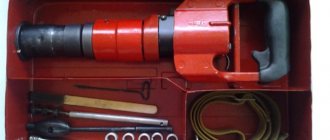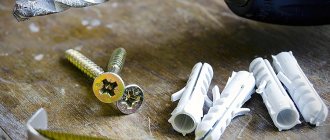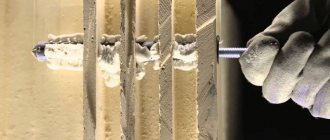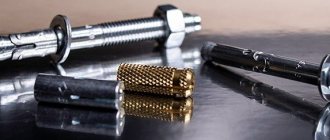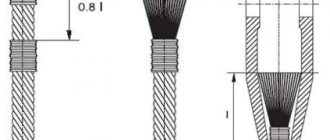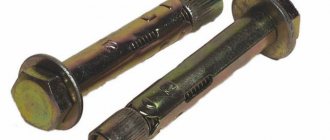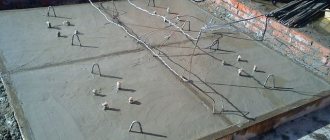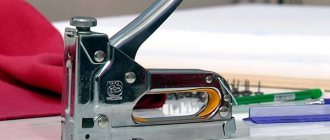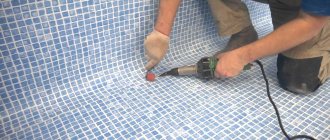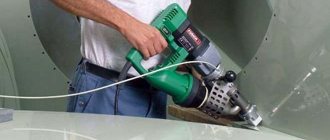Concrete is a widely used building material. It has high hardness and dense structure. During construction or repair work, various elements always have to be attached to it. For this purpose, concrete dowels are used. Therefore, we will tell you about their design and how they differ. Let us also consider the types of such fasteners, the nuances of their selection and fixation in masonry and concrete walls. The information will allow you to competently monitor the work of construction and repair teams.
Manufacturers produce a variety of dowels for concrete structures Source p0.pikist.com
Features of dowels for concrete and brick building structures
The dowels that manufacturers produce for concrete walls and other building structures made of similar material are not the same as fasteners for hollow bricks. To perform the required work efficiently, it is necessary not to confuse these two types of fasteners. Therefore, it is important to know their features.
On a note! It is irrational to use concrete fasteners in brickwork. Such an application is absolutely unjustified when the structure is made of blocks with voids. For masonry, special fasteners with a special device are used. In addition, its installation has certain nuances.
Thus, the design of fastening elements for brickwork with voids usually contains:
- Conical rim. It is necessary to control the installation depth of fasteners.
- Special tip. Thanks to its presence, the fastener twists when a screw is screwed into it.
- Locking wings that prevent the product from turning when screwing in hardware.
An example of dowels used in hollow masonry Source stroy-podskazka.ru
A concrete wall or other similar structure made of the same material is a solid element. Special fasteners are used for it. This is exactly what a concrete dowel is. Experts have been using this fastener for a long time. The classic option is the so-called dowel-nails.
The dowel itself is a spacer element. For concrete, manufacturers make it from different plastics, nylon material and even metal. Depending on the material used, dowels have certain parameters. It is the characteristics that influence the scope of application of spacer bushings.
Each dowel in concrete has a certain load-bearing capacity. Its value depends on the design, the so-called bushing, which has notches along its entire surface. It is thanks to them that the fastening element does not rotate in the hole and does not fall out of it even when exposed to the design load.
The design of the bushing also assumes the presence of elastic whiskers. They are always in a compressed position. This feature also affects the reliability of the fastening. In particular, the whiskers prevent the element from being pulled out of the recess.
Dowel with antennae for secure fastening in concrete Source leroymerlin.ru
On a note! The expansion of the sleeve occurs after screwing in, for example, a screw. Its unclamping is carried out due to the presence of slots in the longitudinal direction.
The fastener is fixed into the hole not only mechanically. Manufacturers also produce dowels that are specially designed for porous concrete. Their fixation is carried out with the additional use of special glue. First, a hole is made into the building structure. Then it is filled with adhesive. Then the fasteners are placed. Thanks to the glue, the fastening element is securely fixed in the cavity.
A dowel nail for concrete in a classic design is a universal product. Therefore, it is used in different fields. With the help of this fastener you can solve various important tasks. It allows:
- install different frames;
- fix furniture, paintings and other similar interior elements to structures;
- secure household technical devices.
Dowel-nail for fastening frames Source stroyka-hoz.ru
Today, builders and repair teams can use steel or aluminum nails for concrete for installation processes. This fastener is simply driven, for example, with a hammer into the created holes. It speeds up installation processes. Therefore, it is widely used during construction, repair, and finishing work.
Installation of a ventilated facade
A ventilated facade is a method of cladding a house in which an air gap of at least 3 cm is provided between the outer layer - the cladding - and the inner layers - the wall, insulation and waterproofing.
This sheathing device has an important property - water vapor escaping from the thickness of the wall materials can freely exit the insulation. To put it simply, there is a constant opportunity to dry the wall and insulation
This option allows you to increase the service life of all materials that make up the thickness of the wall and ensures high-quality performance of the insulation. For facade panels, a ventilated facade is the usual type of installation, although installation without it is possible, directly on wooden walls.
The difference between dowels for concrete surfaces and similar elements for brick structures
Any such product allows for reliable fastening of various parts and objects only if it is correctly selected for specific conditions of use. When choosing, be sure to take into account the dimensions of the fastener and the base material where it is fixed.
Dowels for a brick wall have a different design than fasteners for concrete. For masonry, elongated products are mainly used. This is not their only difference.
Long nylon dowel Source vsmete.ru
Therefore, before fixing a dowel in a hollow brick, you need to thoroughly study its features. So, it often looks like a sleeve made of plastic or metal. Its design includes a spacer mechanism. It is double, which guarantees the fixation of at least one part of it on the material, and not in the void of the brickwork.
A threaded rod can serve as a spacer for the bushing. This is, for example, a pin whose diameter corresponds to the dowel used. Other anchors can also be used. They are selected for a specific load.
In addition, manufacturers produce special concrete nails for hammering. Their operating principle differs from similar fasteners for bricks. The nails are intended for use exclusively in non-porous materials with a hard structure. Even when using a hammer, significant efforts are made to hammer them into the created holes in building structures.
Fasteners in the form of nails for concrete surfaces Source pronailers.ru
Nails made specifically for concrete should not be attempted in brick substrates. This especially does not need to be done if the structures have a large number of air cavities. Otherwise, the holes where the so-called nails are driven will collapse.
On a note! It is impossible to reliably fix even a metal dowel for concrete in brickwork. Moreover, this cannot be done if it is made of plastic. The reason for this is the lower strength of the brick, especially if it is hollow, compared to a concrete structure.
Manufacturers still produce universal fasteners. It is mainly made of nylon. Such fasteners include:
- type N – four-spacer product;
- type S – fasteners with locking tabs;
- type U - an elastic element that twists when it enters a void;
- type K – fasteners with spacers located along its entire length;
- type T - a product with three thrusts.
Three-expansion universal dowel Source main-cdn.goods.ru
In fact, manufacturers produce a huge number of dowels in a universal design. This must be taken into account when selecting fasteners. The process must be approached responsibly. After all, structures are created from building materials of different hardness. Therefore, fixation of fasteners in them is carried out subject to certain rules.
See also: Catalog of construction companies that have their own production of materials and components for the construction of houses
Overview of species
The development of expansion dowels has led to the emergence of several types. Let us highlight those that were developed for installation in a brick wall.
They can be classified according to several criteria:
- dimensions (length and diameter);
- application (construction, facade, universal);
- according to the type of brick for which they are used (solid or hollow);
- according to the method of fastening;
- according to the material.
As you can see, the variety of consumables can be quite large. Let's try to classify them by type, as this happens in a hardware store.
- The first group is united by the common name dowel-nail. This is a universal fastening element that can be successfully used for structures made of solid bricks; it is important not to get into the space between the bricks during drilling, in which case securing such a dowel will be problematic.
- Facade anchor is the fastener most suitable for hollow bricks, although you can try using it for solid bricks. Such dowels are made from both metal and plastic.
- The disc-shaped one is designed for installation of thermal insulation and has an elongated shape with a special device for fixing the insulation without deforming it, the spacer part being at the very end of the dowel.
Main types of dowels
Dowels are classified not only by the material used for their manufacture. They also differ in the installation method. One fastener can be installed into the created holes using only a hammer, while other dowels can be installed using only a special gun. This is exactly the tool that is used when deciding how to hammer a nail into a concrete wall.
When choosing dowels, you always pay attention to the material of the dowels. Plastic products are inexpensive. They are used when mounting non-heavy objects. For heavier structures, metal elements are used.
Plastic dowels Source tildacdn.com
On a note! Metal nails for concrete surfaces have a smooth surface. There is no thread on it. They are difficult to dismantle. They are used when it is necessary to perform fastenings for a long time.
Metal nails for concrete Source 9.allegroimg.com
Spacers are common fasteners. They have a cylindrical shape. They are driven into the created recesses. Often, the design of such fasteners contains spikes. They improve the reliability of fixation.
Dowel with a spacer structure, antennae and spikes Source dgural.ru
There is a fastener, the fixation of which is similar to the principle of operation of the “butterfly”. Such dowels are universal elements. Therefore, they are used in different designs. They seem to open up on each side.
A plastic sleeve that expands to the sides when a screw or self-tapping screw is tightened. Source wkret-met.com
Another type is façade fasteners. It is used when installing frame structures on walls. The facade fastening element has almost the same structure as the product in the spacer design. However, it is distinguished by its longer length and massive cap.
Facade extended dowel with spacer hardware Source a-krep.ru
Dowels are also made exclusively for aerated concrete. They are distinguished by the presence of wide threads. It is this that ensures their reliable fastening in a material with a porous structure. This fastener is designated by the abbreviation KVT.
Fasteners for lightweight concrete Source chelyabinsk.energogradek.ru
Manufacturers also suggest using plastic concrete dowels, used in polystyrene concrete blocks. This type of sleeve is not much different from spacer products. They have a spiral design. This dowel can withstand significant weight. It is often used during the installation of various cabinets, exhaust systems, for attaching shelves and many household items. The abbreviation GB is used to designate the product.
Fasteners for polystyrene concrete Source hubo.be
Application area
Wall shelves are attached to the wall using dowels.
The use of this type of fastener is advisable in various fields. It is an important part that is difficult to find a replacement for. When renovating an apartment, many household appliances and interior items - hoods, wall cabinets, kitchen furniture - must be hung and mounted on the wall. They are held in place thanks to the use of dowels - reliable mounting elements.
Return to contents
Features of choosing the required dowel
Before purchasing fasteners, you need to know the weight of the products that will be fixed with their help. The dimensions of dowel nails for concrete and other elements of similar purposes are also taken into account. In addition, the peculiarities of the mounting location must be taken into account.
There are certain rules that are always followed when choosing dowels:
- Fastening a heavy structure is done using fasteners whose length is at least 85 mm. It is recommended to be used when fixing, for example, exercise equipment.
- If fastening is carried out in a horizontal building structure, then choose products that are placed to a depth of at least 30 mm. In this case, the diameter of such elements should be from 6 to 11 mm.
Spacer element 6*30 mm Source leroymerlin.ru
- When selecting fasteners for an already created hole, you need to select an element with a diameter no less than the same size as the drilled recess. The ideal option is if the dowel and hole have the same diameter.
- Fasteners with antennae should always be used when installing lighting fixtures and ceiling structures. After all, the load acts in the downward direction. The best option is dowels with so-called mustaches and notches.
- If fastening is carried out in hollow brick or other weak material, it is necessary to use fasteners with softening pads. Pouring them will allow you to evenly distribute the load throughout the element, and the fastening itself will be as tight as possible.
Chemical
Chemical dowel for hollow bricks is a product of modern technology. It uses special substances that need to be introduced into the mounting hole. The compound will gain strength as this composition hardens.
Chemical compounds work based on the forces of cohesion and adhesion. These fasteners are used for connecting and fixing various building materials, as well as structures and products made from different materials. As for the strength of the connection that can be obtained, it is highly reliable. It significantly exceeds the characteristics of any friction anchors, expansion dowels and other types of fasteners. The chemical dowel for hollow bricks creates connections where the pull-off force is 2.5 times higher than any traditional one.
Features of fastening dowels in a concrete wall
Of course, you need to invite a specialist to do the work. After all, the master will, at a minimum, take with him all the necessary tools, and at a maximum, he will have impressive experience in performing such operations. Professionals usually carry out the process as follows:
- Mark the installation location of the dowel after careful marking in accordance with the drawings and features of the structure being mounted.
- Make a small indentation at the marked point using, for example, a nail.
- Insert a drill of a suitable diameter into the hammer drill.
- Make a hole in the structure.
Important! The dowel must be inserted into the recess with force. This is the only way it will be fixed in the hole, which is made perpendicular to the plane of the building structure.
- Remove all debris from the recess.
- Insert the element until it stops.
- Screw a screw into the dowel (the hardware can be screwed together with some part, depending on the features of the structure being mounted).
The procedure for fixing a dowel in a concrete wall Source europartner-online.ru
On a note! Before hammering a dowel into a concrete wall, select the required fasteners. It is thicker than conventional wood hardware. It is made from special grades of steel with a massive head. In addition, it may have longitudinal or spiral notches.
Typically, craftsmen use a construction gun to drive such nails into concrete structures. However, it is often necessary to perform a small amount of work manually. This is more difficult, but the right tool may not always be nearby.
Usually they try to drive special nails into concrete surfaces without defects. There should be no chips or cracks on them. Otherwise, the hardware will not hold well.
Before the process itself, the washer is removed from the metal dowel of the nail. Then clamp the hardware in pliers. Then they install it in the desired anchored place and hammer it in with strong blows.
Accessories
In addition to ordinary panels, additional elements are required to install the sheathing. Components, or, as they are also called, additional elements, without which it will be difficult to sheathe a house (photo below):
- Starting bar. This is a special rail with a groove for installing the bottom row of panels.
- J-bar. Serves to complete the cladding fabric, or for any design of the junction of the fabric to other planes (for example, when decorating window openings, it limits the window frame from the side of the window block).
- Corner profile. An element used to finish external corners. For Deke panels, installation of corner profiles is much easier, since they are mounted on top of the panels on both sides of the corner and cover them. They do not have a typical groove into which the sides of the panels are inserted. To ensure reliable installation, there is a starting corner profile that serves as a reference point for the corner profile.
- Border. Used to decorate the end sections of the canvas, overhangs or other areas. To install it use
- Basic plank. Used for decorating internal corners, attaching borders, etc.
- Facade near-window profile. Serves as a support strip when finishing window or door openings.
- Inner corner. Used to decorate the internal corners of the surface.
The list of additional elements for Deke façade panels is much shorter than is the case with conventional types of siding, and the installation technology is simpler and clearer, which is also an advantage of the material.
Features of fixing fasteners in brick
Experts note that fixing fasteners in masonry is more difficult than fixing a similar element in concrete. Although professionals quickly solve this problem even when installing structures with significant weight.
First of all, before fixing the anchor in the hollow brick, the exact anchoring depth is determined. It must be no less than or maximum equal to the distance from the corner of the building structure to the installation point.
In addition, qualified craftsmen often consider the minimum length of the screw used. To do this, fold the same size dowel and the sharp part of the hardware. The last parameter is usually equal to the diameter of the screw. In addition, the thickness of the mounted part is added to the obtained value.
The value obtained as a result of addition is rounded up. In this case, they are guided by standard lengths of hardware. At the end of the entire calculation, the required depth of the hole in the brick structure is determined. It should be greater than or at most equal to the length of the selected hardware minus the thickness of the attached part.
The depth of the hole in the brick must be no less than the length of the hardware used minus the thickness of the fixed part Source sdelai-lestnicu.ru
On a note! If you decide to use a dowel or nail for brick, then it is better to use it in a solid block. In hollow material it may adhere poorly or not at all. We are talking about a plastic dowel with pointed threaded hardware. It also has a cross slot.
A high-quality installation process for fixing dowels in bricks is as follows:
- A recess is created for fixing the fastener.
Important! To drill a recess, use a power tool without impact. Otherwise, the brick may crack or break off, especially if it is hollow. In addition, due to tool impacts, sometimes the recess is larger in diameter than the dowel used. After all, brick is a softer building material compared to concrete.
Brick and other similar blocks are softer compared to monolithic concrete Source sun9-24.userapi.com
- All debris is blown out of the created hole.
Advice! To more securely secure the fasteners in the recess, tile adhesive is additionally used. It is diluted in accordance with the instructions, which are always present on the packaging. Fill the hole as deep as possible with the mixture.
- Insert the element into the recess until it stops.
- Wait for the adhesive to cure. It hardens in about 24 hours.
- Screw threaded hardware into the dowel.
The screw or pin must fit into the installed fastener with force. If the element is not installed securely, then it will scroll. With high-quality installation, such fasteners can withstand significant loads.
This method of fixing a dowel in a wall is often used if the structure is made of hollow material. It is often used in foam blocks.
Facade self-tapping screw
In general, self-tapping screws are made of galvanized and stainless steel. But, if we are talking specifically about a facade self-tapping screw, which can be used to fasten a metal profile in a ventilation facade, then it is necessary to use a stainless steel self-tapping screw.
It doesn't matter whether the system is aluminum or galvanized. A stainless steel self-tapping screw is always used
An aluminum system, if secured with a galvanized screw, will enter into a chemical reaction and begin to rust. The fact is that different types of metals react with each other, the reaction is called “galvanic couple” - this is their chemistry course, seventh grade.
Non-ferrous and ferrous metals cannot be used together. Painted self-tapping screws are also prohibited, because When screwed in, the paint will come off. Therefore, for aluminum systems it is necessary to use only stainless steel self-tapping screws.
It may be strange and illogical, but galvanized self-tapping screws cannot be used for ventilation facades. Because galvanized screws are short-lived. And between the head of the screw and the profile, water can accumulate, increasing the corrosion of metals.
And since the systems are subject to increased reliability requirements, it is necessary to use a stainless steel self-tapping screw for metal profiles in accordance with the permitting documentation.
Features of application
Thanks to its sharp tip, the self-tapping screw can be easily screwed into metal whose thickness does not exceed 2 mm. The self-tapping screw is screwed in using a screwdriver, which, on the one hand, is very convenient, installation speed increases, and a minimum of effort is applied to screwing.
On the other hand, the screwdriver limits operation at temperatures below 20 degrees. He starts to work worse. The system can be installed at lower temperatures. Restrictions on the installation of the system are either related to the human factor, when people physically cannot work in the cold. Or the equipment refuses to work.
Self-tapping screws are not recommended for galvanized systems. But in aluminum systems, on the contrary, they are recommended. Why this is so is very simple.
Aluminum is a tough metal. And if you don’t screw the screw in - unscrew it, screw it in again - unscrew it, then the screw will fit tightly and get stuck. But in galvanized metals, the self-tapping screw does not fit well.
Firstly, the galvanized profile has a small thickness. Secondly, the self-tapping screw becomes unscrewed under vibration loads, which inevitably exist in any city. Therefore, a rivet is used for galvanized systems. Let's look at it below.
Features of dismantling work
During renovation work, building structures are often leveled. To ensure a high-quality process, the previously installed dowels are first removed. To dismantle them, use a regular screw or other hardware of a suitable diameter. It is screwed into the fastener by 2/3 of the length or more. It all depends on the tool that is additionally used in the work. Then the hardware is pulled out along with the plastic fastener.
To pull the dowel out of the wall, use suitable hardware Source bau-meister.ru
On a note! Usually, a steel crowbar or ordinary pliers are used for pulling out.
Sometimes a situation arises when a piece of metal hardware remains in a plastic fastener. To remove it, use a soldering iron. They first heat up a plastic dowel, and then use pliers to pull out a piece of steel fastener.
When the dowel is set very tightly, sometimes it cannot be pulled out. The fasteners are simply cut along the plane of the structure, and the hole is covered with a durable mixture.
If you need to remove a special metal nail from a structure, first loosen the hardware with hammer blows. After this, a nail puller is used for its final dismantling.
As a last resort, a hole is drilled next to the dowel-nail. It makes it easier to loosen the hardware. You can also use a grinder to simply cut off a special steel nail.
A protruding special metal nail can be trimmed with a grinder Source mcmahons.ie
Briefly about the main thing
A dowel for masonry or concrete is a fastener made of steel or plastic with antennae, protrusions, and spikes. Basically, it expands when the hardware is tightened.
In brick construction, elongated fasteners are mainly used. Special nails are often secured in concrete. Products with a plastic element can be driven in with a hammer, and all-metal sharp fasteners are often installed with a construction gun. It cannot be installed by hitting a brick.
Manufacturers produce spacer, butterfly-shaped, facade, wide-threaded fasteners for aerated concrete and other types of fasteners. It is selected according to the material of the wall in which it is installed. The applied load is also taken into account.
The dowel is mounted into the previously created hole. It must have a depth no less than the length of the hardware. During installation in brick, an additional adhesive mixture can be used.
According to the operating principle
Dowels are classified according to this criterion as follows, they are:
- Spacer;
- Anchor.
The first ones are designed for holes having a certain diameter; they are suitable for concrete, reinforced concrete, asphalt, wooden surfaces and for wood-based materials.
The latter are capable of not only wedging, but also deformation; they are used when working with hollow bricks, aerated concrete, foam concrete blocks and sheet plasterboard.
